Experimental Investigation of Engine Valve Train Friction Considering Effects of Operating Conditions and WPC Surface Treatment
Abstract
1. Introduction
2. Experimental Setup
2.1. Engine
2.2. Test Bench
3. Instrumentation and Calibration
3.1. Torque Tube
3.2. Calibration Procedure
4. Materials and Methods
5. Data Acquisition
6. Experimental Procedures
7. Results and Discussion
8. Conclusions
Author Contributions
Funding
Institutional Review Board Statement
Informed Consent Statement
Data Availability Statement
Acknowledgments
Conflicts of Interest
References
- Mufti, R.A. Total and Component Friction in a Motored and Firing Engine; University of Leeds: Leeds, UK, 2004. [Google Scholar]
- Roshan, R.; Priest, M.; Neville, A.; Morina, A.; Xia, X.; Green, J.H.; Warrens, C.P.; Payne, M.J. Friction modelling in an engine valve train considering the sensitivity to lubricant formulation. Proc. Inst. Mech. Eng. 2009, 223, 413–424. [Google Scholar] [CrossRef]
- Mufti, R.A.; Priest, M. Experimental and Theoretical Evaluation of Simultaneous Piston Assembly, Valve Train and Engine Bearing Friction in a Fired Engine. In Proceedings of the World Tribology Congress III, Washington, DC, USA, 12–16 September 2005. [Google Scholar]
- Taylor, C.M. Paper VI (i) Valve Train Lubrication Analysis. In Tribology Series; Dowson, D., Taylor, C.M., Godet, M., Eds.; Elsevier: Amsterdam, The Netherlands, 1991; pp. 119–131. [Google Scholar]
- Ball, W.F.; Jackson, N.S.; Pilley, A.D.; Porter, B.C. The Friction of a 1.6 Litre Automotive Engine—Gasoline and Diesel. SAE Trans. 1986, 95, 997–1007. [Google Scholar]
- Pieprzak, J.; Willermet, P.; Dailey, D. Experimental Evaluation of Tappet/Bore and Cam/Tappet Friction for a Direct Acting Bucket Tappet Valvetrain; Society of Automotive Engineers: Warrendale, PA, USA, 1990. [Google Scholar]
- Baniasad, S.M.; Emes, M.R. Design and Development of Method of Valve-Train Friction Measurement. SAE Trans. 1998, 107, 864–880. [Google Scholar]
- Ito, A.; Yang, L.; Negishi, H. A Study on Cam Wear Mechanism with a Newly Developed Friction Measurement Apparatus. SAE Trans. 1998, 107, 2039–2046. [Google Scholar]
- Mufti, R.A.; Priest, M. Experimental and Theoretical Study of Instantaneous Engine Valve Train Friction. J. Tribol. 2003, 125, 628–637. [Google Scholar] [CrossRef]
- Mufti, R.A. Experimental technique for evaluating valve train performance of a heavy duty diesel engine. Proc. Inst. Mech. Eng. 2009, 223, 425–436. [Google Scholar] [CrossRef]
- Zahid, R.; Hassan, M.H.; Alabdulkarem, A.; Varman, M.; Kalam, M.A.; Mufti, R.A.; Zulkifli, N.W.M.; Gulzar, M.; Bhutta, M.U.; Ali, M.A.; et al. Tribological characteristics comparison of formulated palm trimethylolpropane ester and polyalphaolefin for cam/tappet interface of direct acting valve train system. Ind. Lubr. Tribol. 2018, 70, 888–901. [Google Scholar] [CrossRef]
- Arshad, W.; Hanif, M.A.; Bhutta, M.U.; Mufti, R.A.; Shah, S.R.; Abdullah, M.U.; Najeeb, M.H. Technique developed to study camshaft and tappet wear on real production engine. Ind. Lubr. Tribol. 2017, 69, 174–181. [Google Scholar] [CrossRef]
- Staron, J.T.; Willermet, P.A. An Analysis of Valve Train Friction in Terms of Lubrication Principles. SAE Trans. 1983, 92, 625–639. [Google Scholar]
- Sun, D.C.; Rosenberg, R.C. An Experimental Study of Automotive Cam-Lifter Interface Friction. ASLE Trans. 1987, 30, 167–176. [Google Scholar] [CrossRef]
- Lee, J.; Patterson, D.J.; Morrison, K.M.; Schwartz, G.B. Friction Measurement in the Valve Train with a Roller Follower. SAE Trans. 1994, 103, 963–969. [Google Scholar]
- Lee, J.; Patterson, D.J. Analysis of Cam/Roller Follower Friction and Slippage in Valve Train Systems; SAE Technical Paper; SAE: Warrendale, PA, USA, 1995. [Google Scholar]
- Khurram, M.; Mufti, R.A.; Zahid, R.; Afzal, N.; Bhutta, M.U.; Khan, M. Effect of lubricant chemistry on the performance of end pivoted roller follower valve train. Tribol. Int. 2016, 93, 717–722. [Google Scholar] [CrossRef]
- Khurram, M.; Mufti, R.A.; Bhutta, M.U.; Habib, Y.; Ahmed, A.; Afzal, N. A numerical approach to calculate creep in roller follower valve train basing on friction and lubrication modeling. Trans. Can. Soc. Mech. Eng. 2015, 39, 805–818. [Google Scholar] [CrossRef]
- Khurram, M.; Mufti, R.A.; Zahid, R.; Afzal, N.; Bhutta, U. Experimental measurement of roller slip in end-pivoted roller follower valve train. Proc. Inst. Mech. Eng. 2015, 229, 1047–1055. [Google Scholar] [CrossRef]
- Bhutta, M.U.; Khan, Z.A. Wear and friction performance evaluation of nickel based nanocomposite coatings under refrigerant lubrication. Tribol. Int. 2020, 148, 106312. [Google Scholar] [CrossRef]
- Bhutta, M.U.; Khan, Z.A.; Garland, N. Wear Performance Analysis of Ni–Al2O3 Nanocomposite Coatings under Nonconventional Lubrication. Materials 2019, 12, 36. [Google Scholar] [CrossRef] [PubMed]
- Zahid, R.; Hassan, M.B.H.; Alabdulkarem, A.; Varman, M.; Mufti, R.A.; Kalam, M.A.; Zulkifli, N.W.B.M.; Gulzar, M.; Lee, T. Investigation of the tribochemical interactions of a tungsten-doped diamond-like carbon coating (W-DLC) with formulated palm trimethylolpropane ester (TMP) and polyalphaolefin (PAO). RSC Adv. 2017, 7, 26513–26531. [Google Scholar] [CrossRef]
- Zahid, R.; Hassan, M.B.H.; Varman, M.; Mufti, R.A.; Kalam, M.A.; Zulkifli, N.W.B.M.; Gulzar, M. A Review on Effects of Lubricant Formulations on Tribological Performance and Boundary Lubrication Mechanisms of Non-Doped DLC/DLC Contacts. Crit. Rev. Solid State Mater. Sci. 2017, 42, 267–294. [Google Scholar] [CrossRef]
- Zahid, R.; Masjuki, H.H.; Varman, M.; Kalam, M.A.; Mufti, R.A.; Zulkifli, N.W.B.M.; Gulzar, M.; Azman, S.S.B.N. Influence of intrinsic and extrinsic conditions on the tribological characteristics of diamond-like carbon coatings: A review. J. Mater. Res. 2016, 31, 1814–1836. [Google Scholar] [CrossRef]
- Mao, B.; Siddaiah, A.; Liao, Y.; Menezes, P.L. Laser surface texturing and related techniques for enhancing tribological performance of engineering materials: A review. J. Manuf. Process. 2020, 53, 153–173. [Google Scholar] [CrossRef]
- Etsion, I. Improving Tribological Performance of Mechanical Components by Laser Surface Texturing. Tribol. Lett. 2004, 17, 733–737. [Google Scholar] [CrossRef]
- Lu, P.R.; Wood, J.K. Tribological performance of surface texturing in mechanical applications—A review. Surf. Topogr. Metrol. Prop. 2020, 8, 043001. [Google Scholar] [CrossRef]
- Zahid, R.; Bhutta, M.U.; Mufti, R.A.; Abdullah, M.U.; Masjuki, H.H.; Varman, M.; Kalam, M.A.; Ali, M.A.; Aslam, J.; Akhtar, K. Friction and Wear Performance Evaluation of Bio-Lubricants and DLC Coatings on Cam/Tappet Interface of Internal Combustion Engines. Materials 2021, 14, 7206. [Google Scholar] [CrossRef] [PubMed]
- Waqas, M.; Zahid, R.; Bhutta, M.U.; Khan, Z.A.; Saeed, A. A Review of Friction Performance of Lubricants with Nano Additives. Materials 2021, 14, 6310. [Google Scholar] [CrossRef] [PubMed]
- Ul Islam, T.; Khurram, M.; Umar, M.; Mufti, R.A.; Akhtar, K. Experimental and theoretical evaluation of friction in roller follower valve train. Measurement 2020, 160, 107808. [Google Scholar] [CrossRef]
- Torabi, A.; Akbarzadeh, S.; Salimpour, M. Comparison of tribological performance of roller follower and flat follower under mixed elastohydrodynamic lubrication regime. Proc. Inst. Mech. Eng. 2017, 231, 986–996. [Google Scholar] [CrossRef]
- Abdullah, M.U.; Shah, S.R.; Bhutta, M.U.; Mufti, R.A.; Khurram, M.; Najeeb, M.H.; Arshad, W.; Ogawa, K. Benefits of wonder process craft on engine valve train performance. Proc. Inst. Mech. Eng. 2019, 233, 1125–1135. [Google Scholar] [CrossRef]
- WPC Treatment Machines. Available online: https://www.fujikihan.co.jp/en/88.php (accessed on 3 November 2022).
- Fujikihan Co., Ltd. WPC Processing of Parts. Available online: https://www.fujikihan.co.jp/en/14.php (accessed on 3 November 2022).
- Fuji Kihan Co., Ltd. Development of an Innovative Method for Mechanical Surface Treatment of Metal Products by Collision of Fine Particles at High Speed. The 3rd Monodzukuri Nippon Grand Award. Available online: https://jgoodtech.smrj.go.jp/en/web/page/corp/-/info/JC0000000001541/appeal/eng (accessed on 3 November 2022).
- Toyo Seiko Co., Ltd.; WPC® (Wonder Process Craft). What is WPC®? Available online: https://www.fujikihan.co.jp/en/09.php (accessed on 3 November 2022).
- WPC Treatment Metal Surface Treatment for Motor Sport. Available online: http://wpctreatment.com (accessed on 3 November 2022).
- Fuji Manufacturing Co., Ltd. WPC Treatment—(Wonder Process Craft) Metal Parts, Die, Blade, Tools, All Last Several Times Longer!! Available online: https://www.fujimfg.co.jp/english/wpc.html (accessed on 3 November 2022).
- Fuji Manufacturing Co., Ltd.; Fuji Kihan Co., Ltd. Sliding Resistance Reduced! Improved Abrasion Quality. Patent 1594395, 26 May 1999. Available online: https://patents.google.com/patent/JPH11347944A/en (accessed on 3 November 2022).
- Fujikihan Co., Ltd. What Is WPC? Effects of WPC Processing. Available online: https://www.fujikihan.co.jp/en/05.php (accessed on 3 November 2022).
- EMANAK. WPC Treatment®. Enables Surface Treatment and Thermal Treatment of Metal Products Effective for Extending the Life of Machine Parts, Cutting Tools, and Dies. Available online: https://emanak.co.jp/en/thermal-transaction/wpc/ (accessed on 3 November 2022).
- Scientific, B. The Influence of Surface Roughness on Wettability in Paper and Board. Available online: https://www.biolinscientific.com/blog/influence-of-surface-roughness-on-paper-and-board-wettability#:~:text=Did%20you%20know%20that%20surface,effect%20of%20the%20surface%20chemistry (accessed on 3 November 2022).
- Wenzel, R.N.J.I.; Chemistry, E. Resistance of solid surfaces to wetting by water. Ind. Eng. Chem. 1936, 28, 988–994. [Google Scholar] [CrossRef]
- Bhutta, M.U.; Khan, Z.A. Friction and wear performance analysis of hydrofluoroether-7000 refrigerant. Tribol. Int. 2019, 139, 36–54. [Google Scholar] [CrossRef]
- Mufti, R.A.; Priest, M. Experimental evaluation of engine valve train friction under motored and fired conditions. In Tribology Series; Dowson, D., Taylor, C.M., Godet, M., Eds.; Elsevier: Amsterdam, The Netherlands, 2003; pp. 767–778. [Google Scholar]
- Abdullah, M.U.; Bhutta, M.U.; Najeeb, M.H.; Khurram, M.; Mufti, R.A.; Shah, S.R. Experimental Measurement of Frictional Torque in End Pivoted Roller Finger Follower Valve Train. In Proceedings of the 6th International Conference on Developments in Engineering and Technology: ICDET-2017, Bangkok, Thailand, 6–7 February 2017. [Google Scholar]
- Bhutta, M.; Shah, S.R.; Abdullah, U.; Ashraf, M.N.; Khurram, M.; Mufti, R.A. Effect of Lubricant Inlet Pressure on the Roller Slip in Roller Follower Valve Train. In Proceedings of the International Congress on Recent Development in Engineering and Technology, Kuala Lumpur, Malaysia, 22–24 August 2016; pp. 15–18. [Google Scholar]
- Khurram, M.; Mufti, R.A.; Bhutta, M.U.; Afzal, N.; Abdullah, M.U.; ur Rahman, S.; ur Rehman, S.; Zahid, R.; Mahmood, K.; Ashfaq, M.; et al. Roller sliding in engine valve train: Effect of oil film thickness considering lubricant composition. Tribol. Int. 2020, 149, 105829. [Google Scholar] [CrossRef]
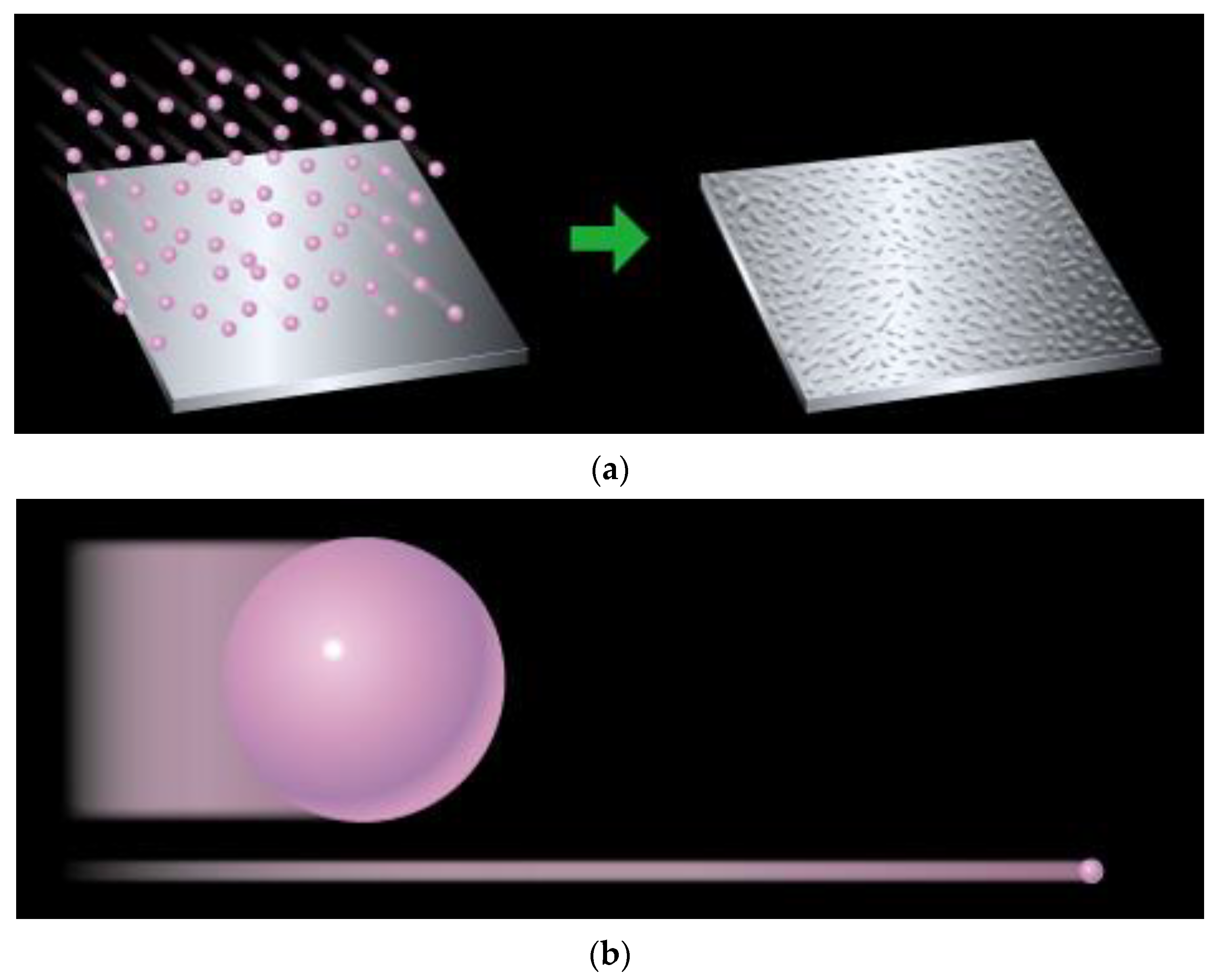

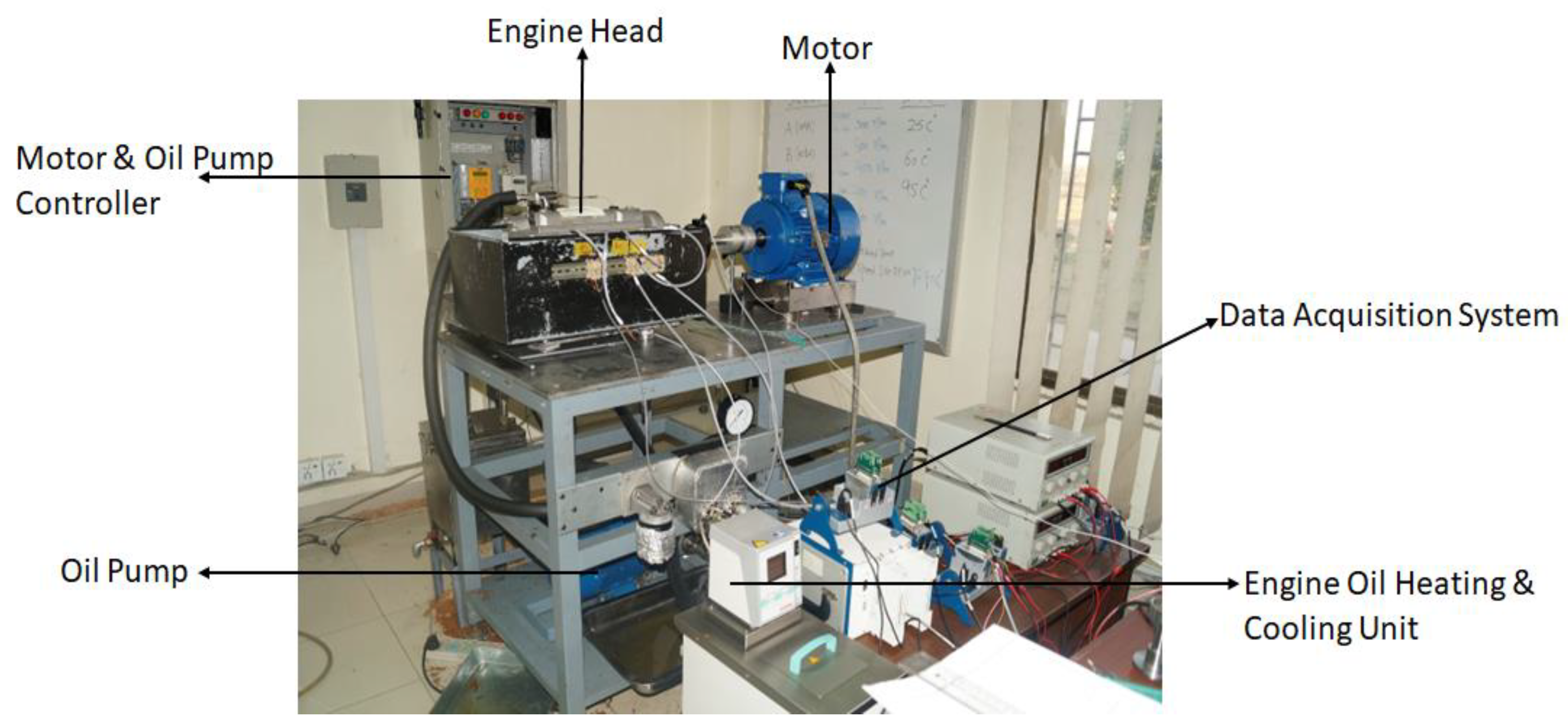
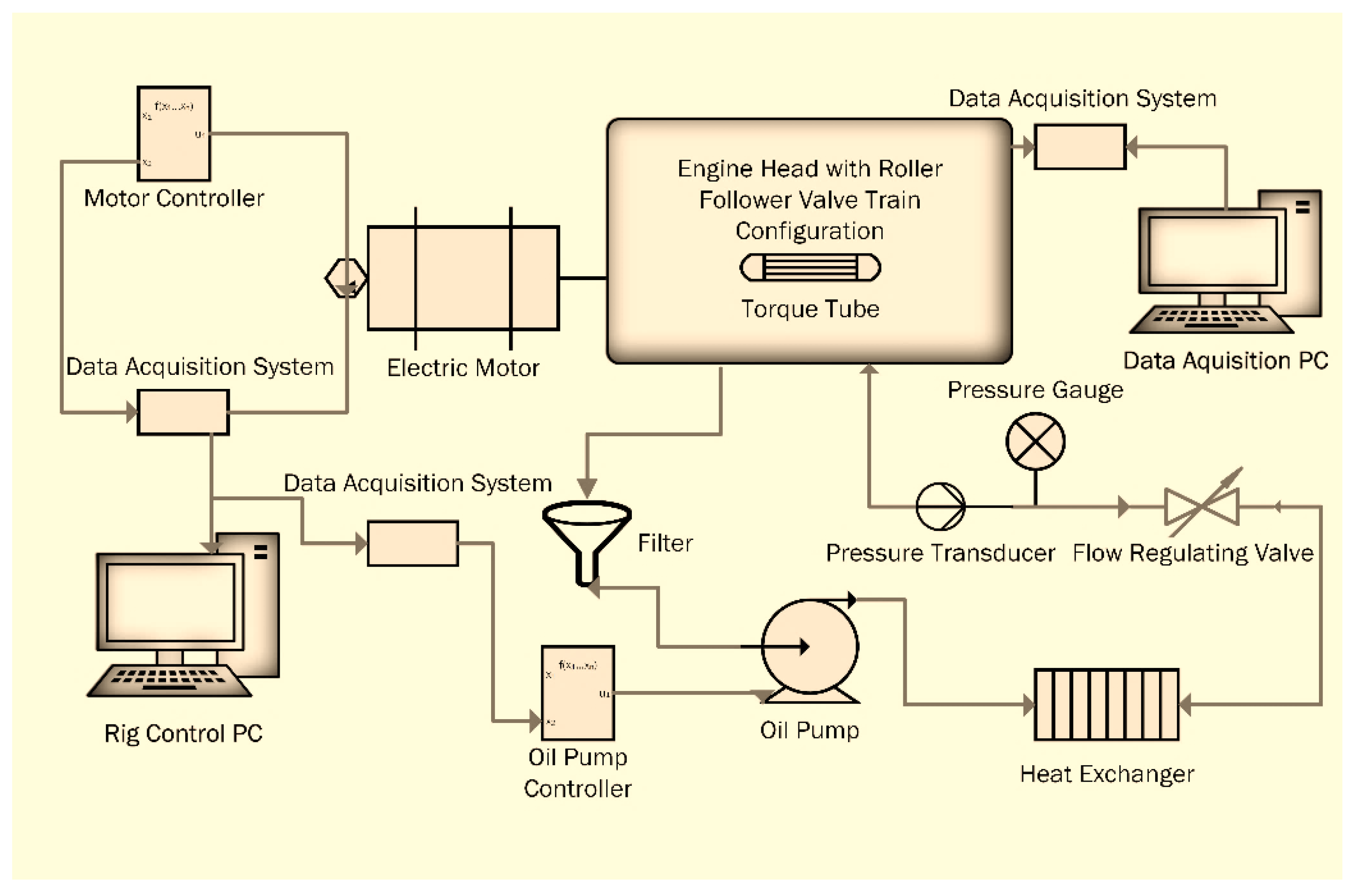
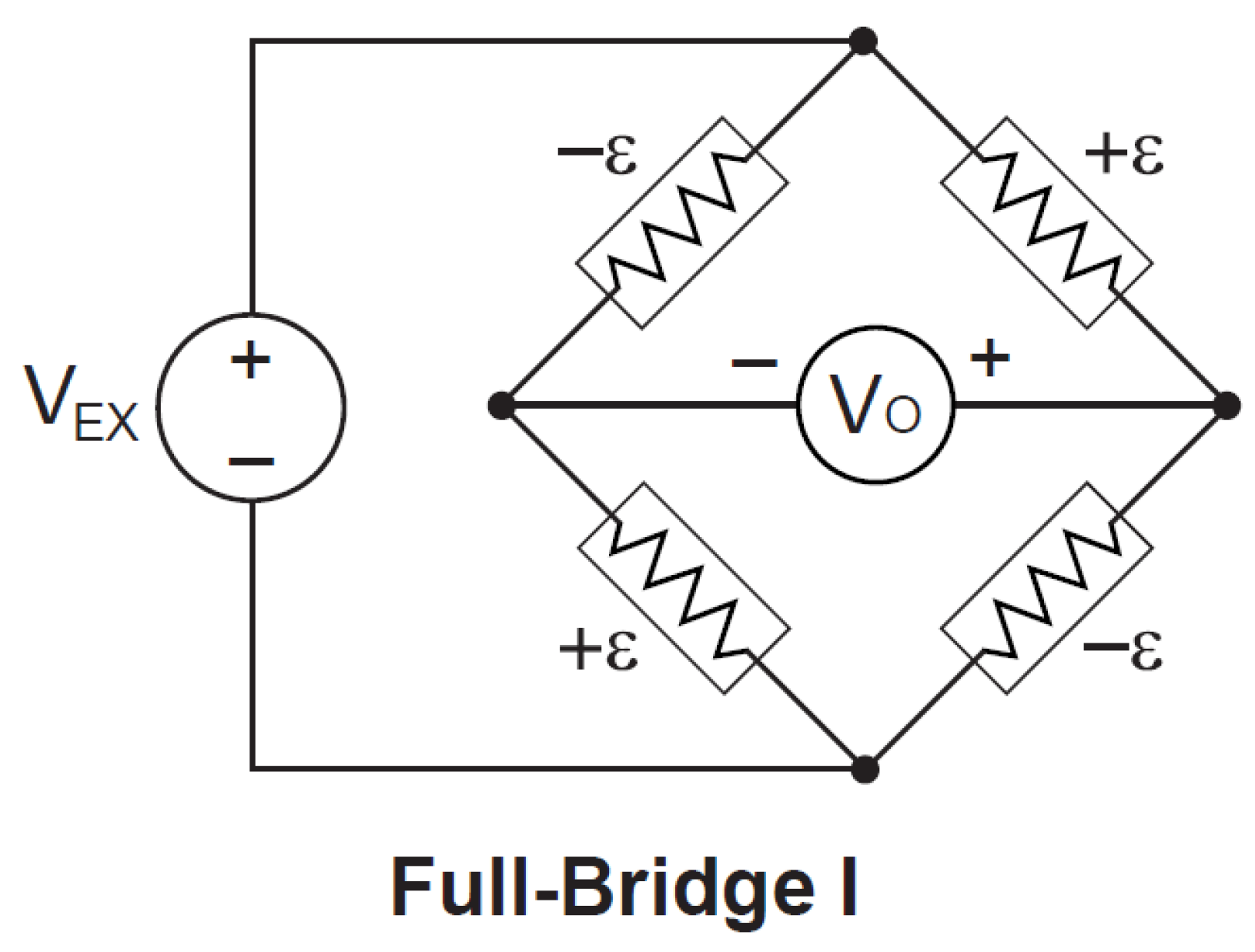

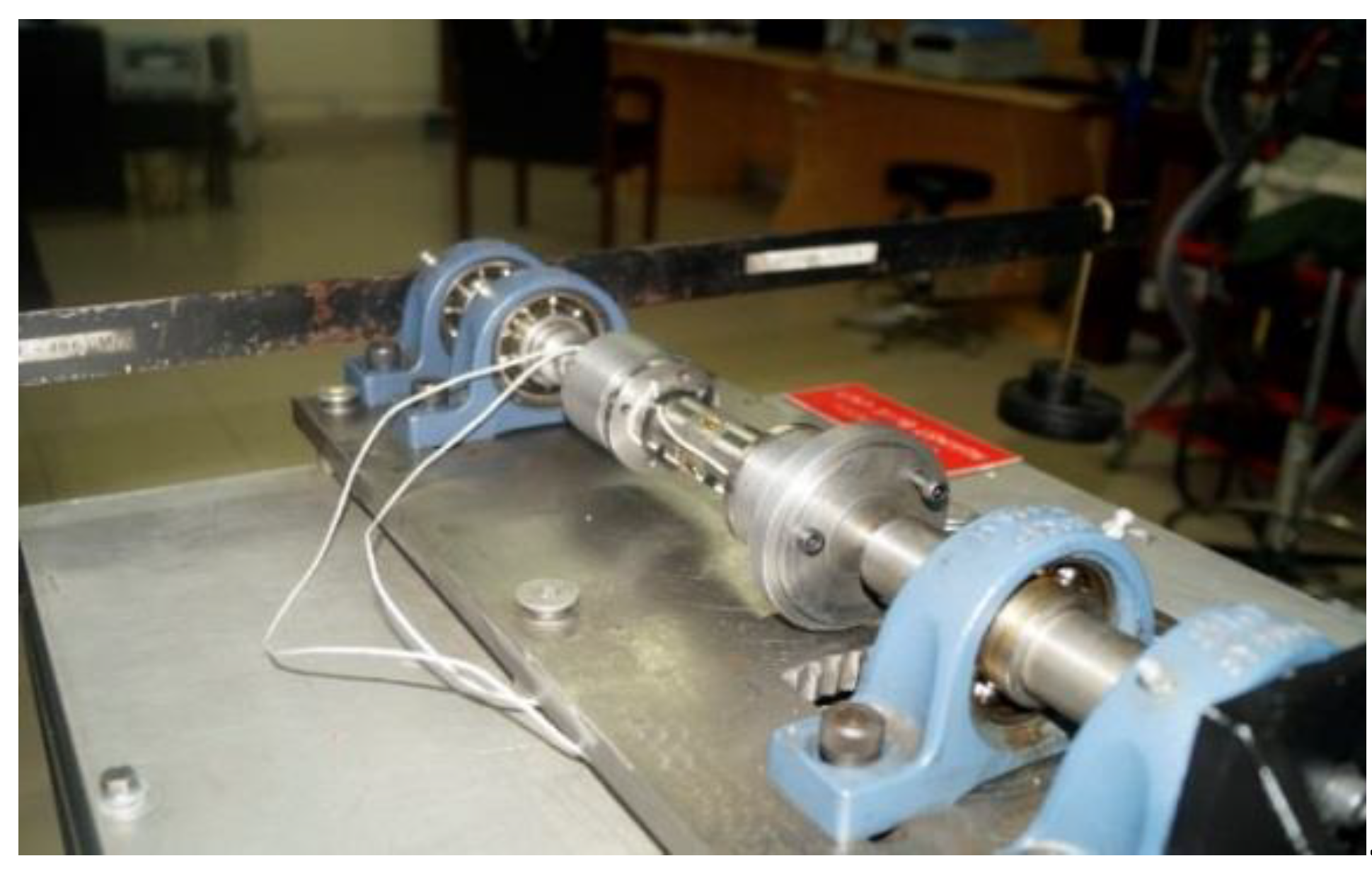
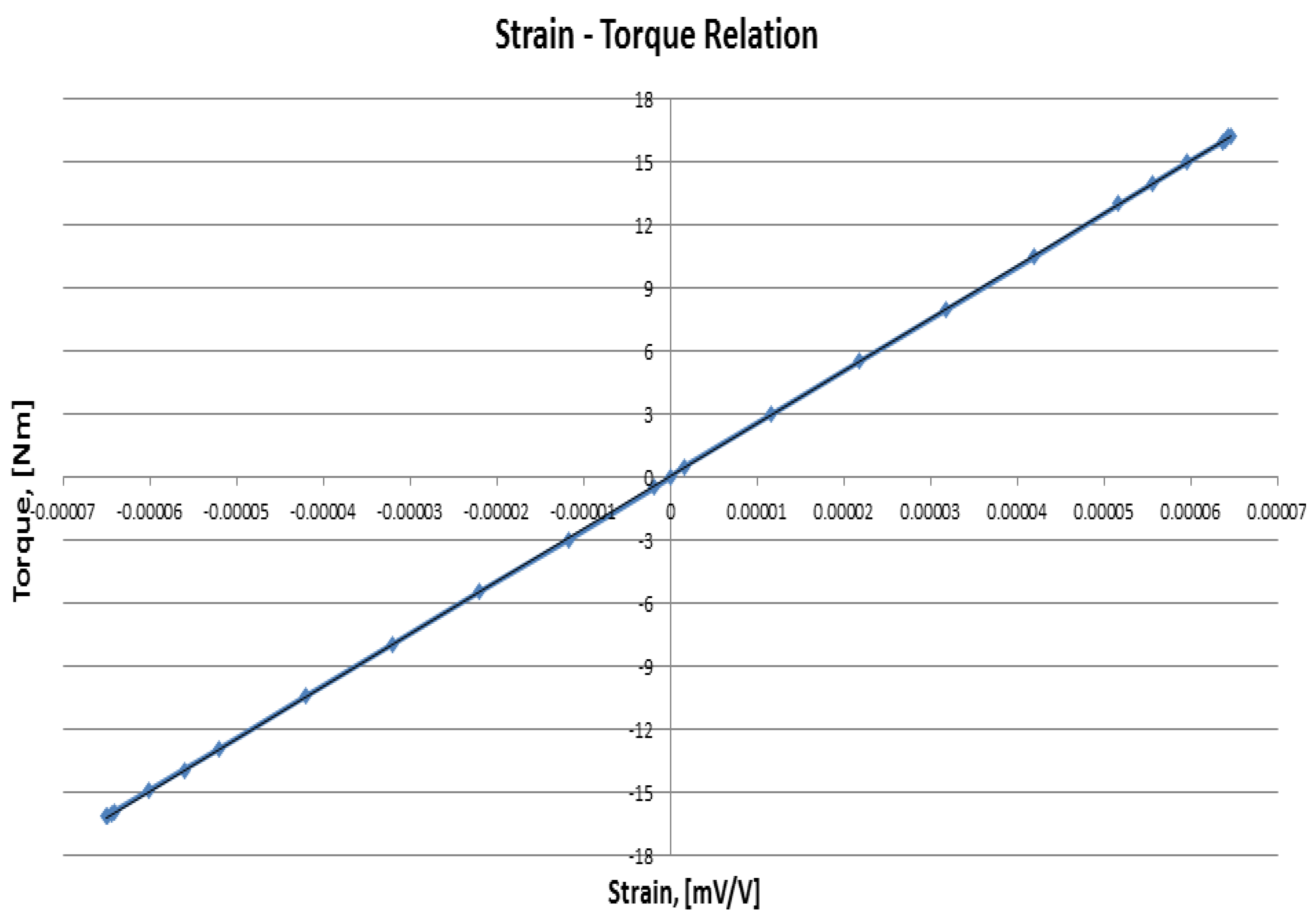
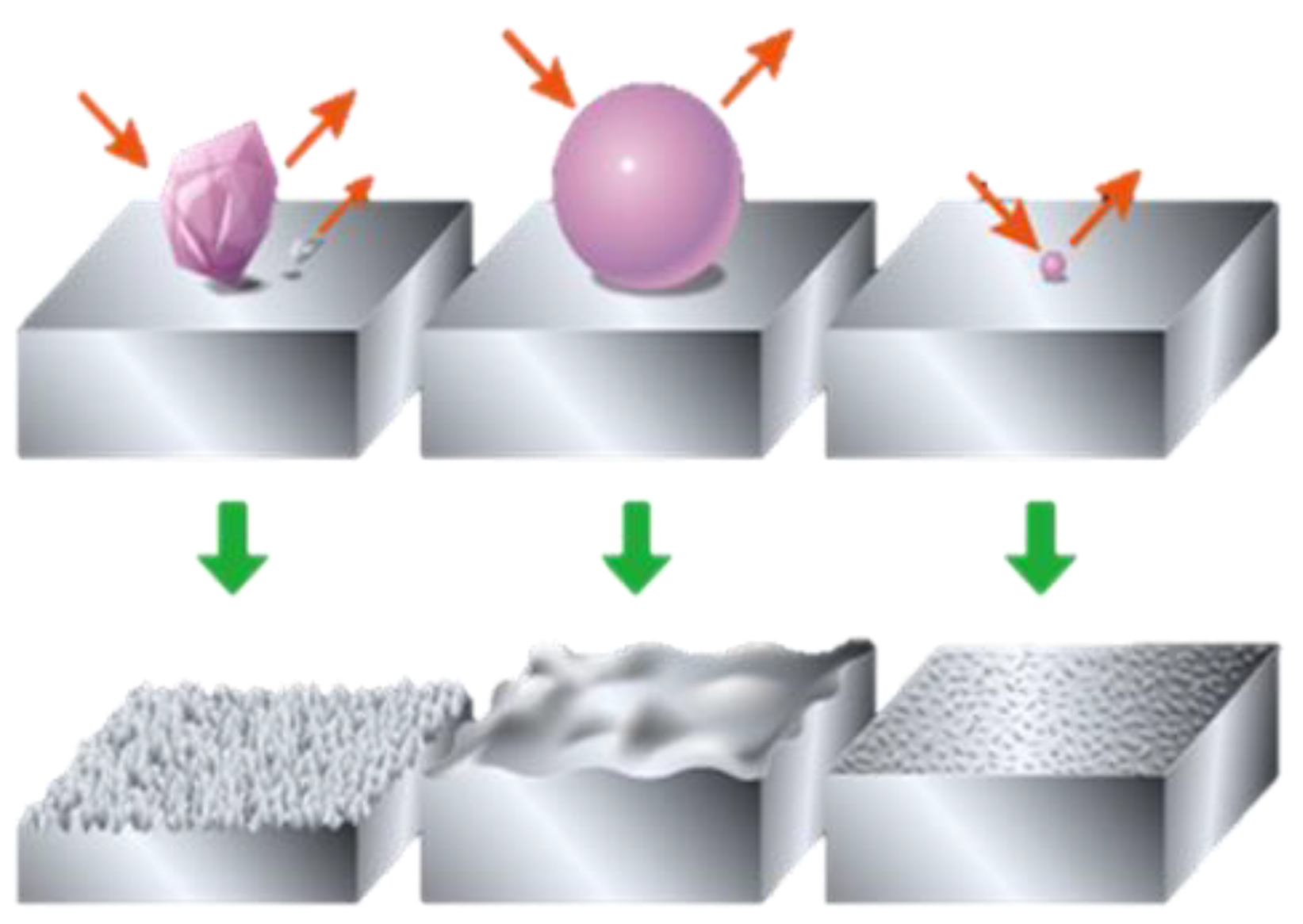
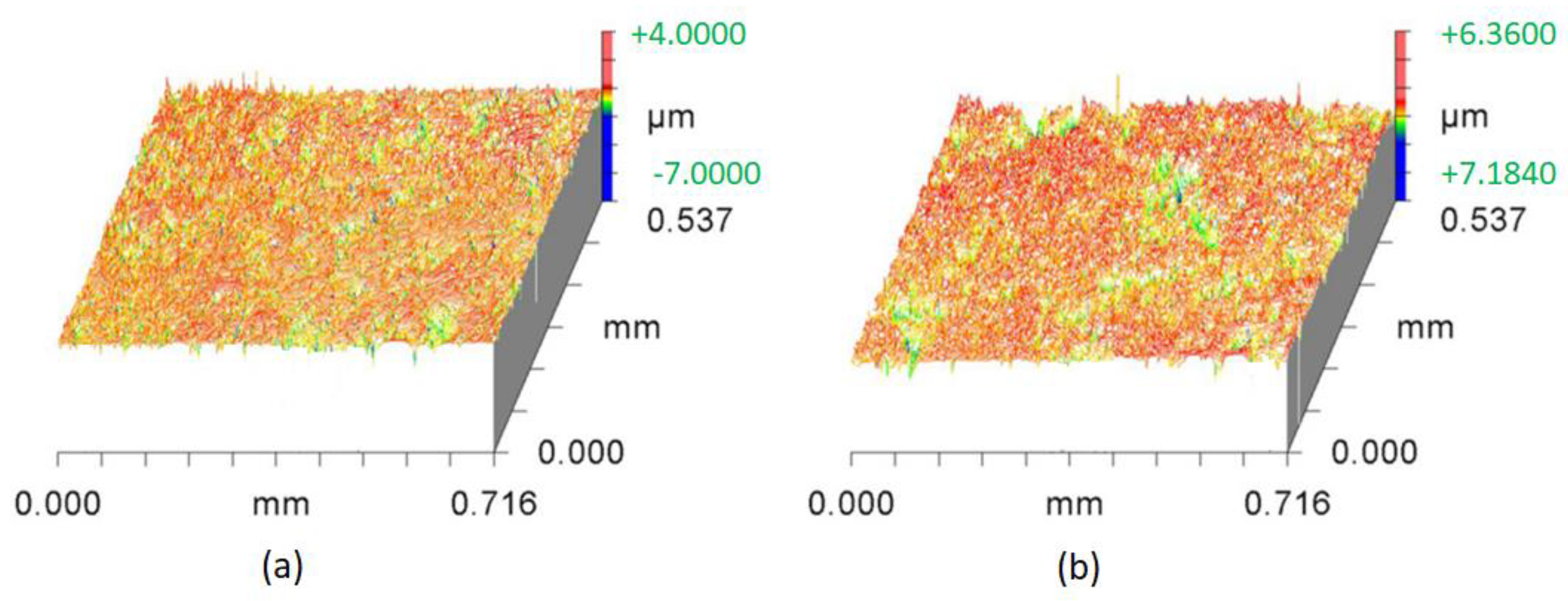
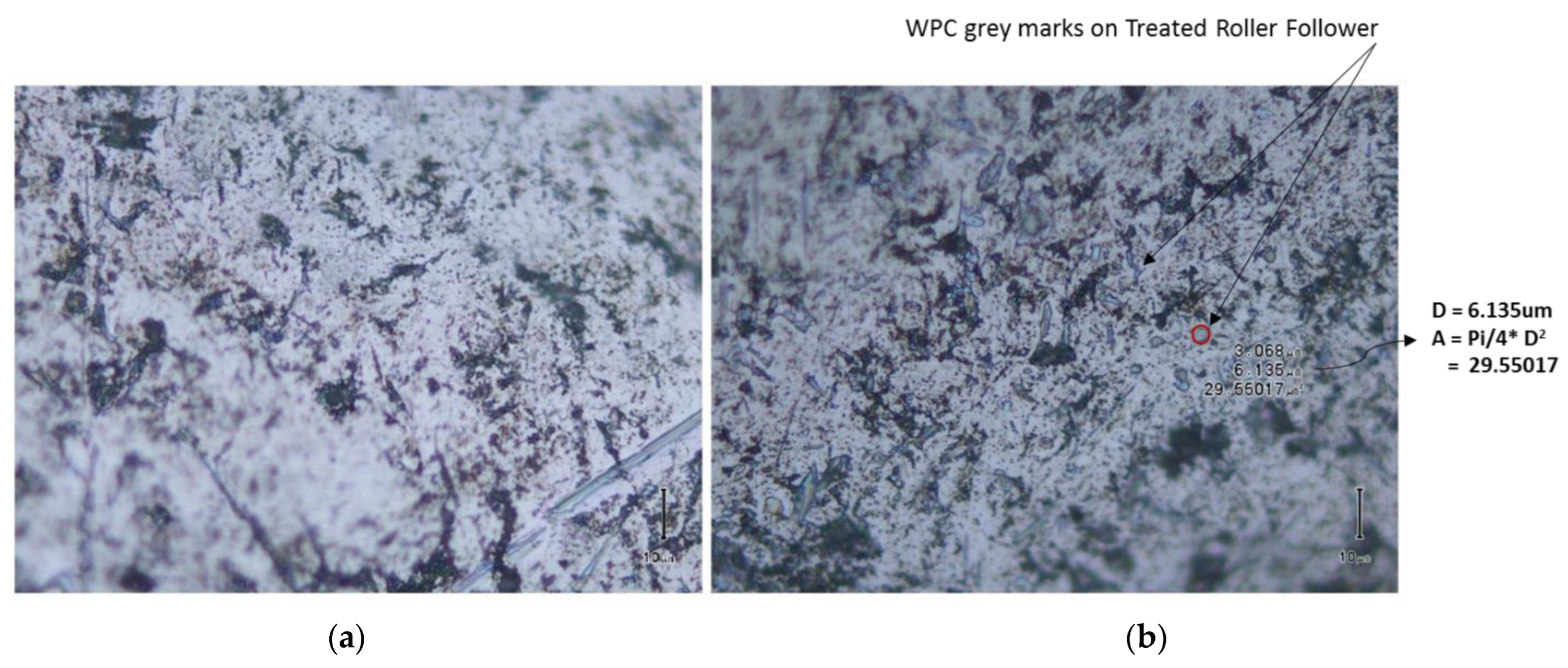
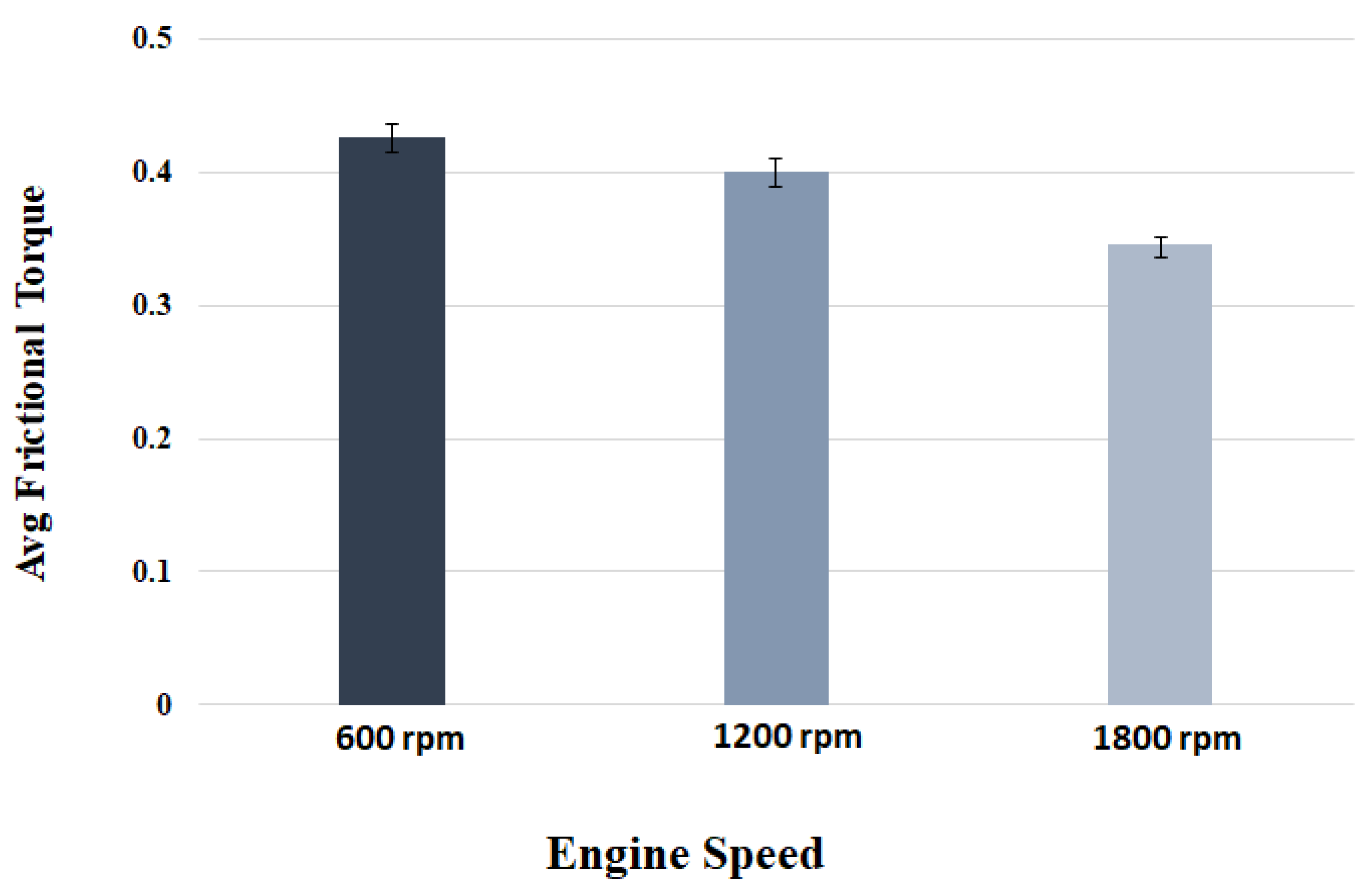


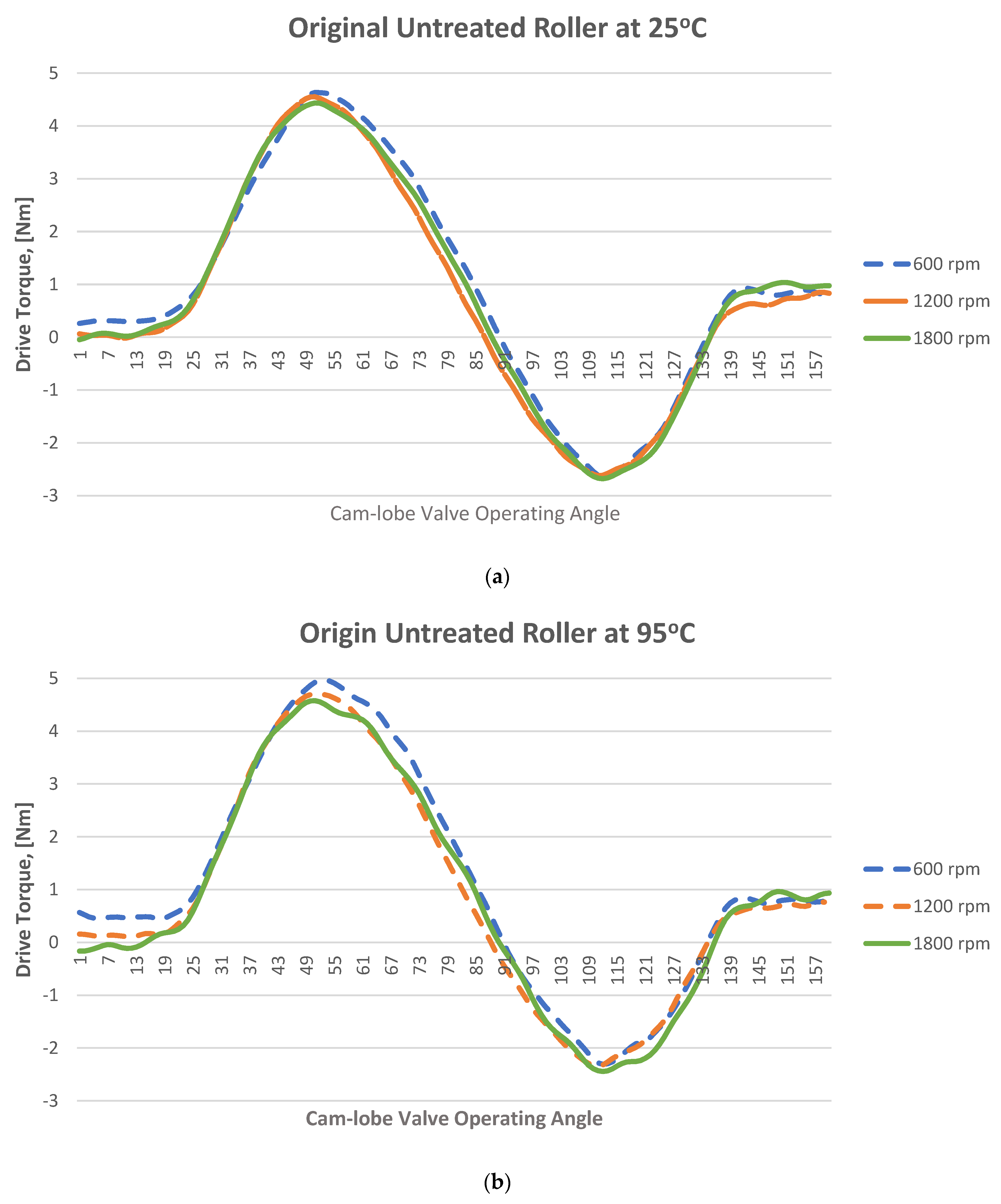
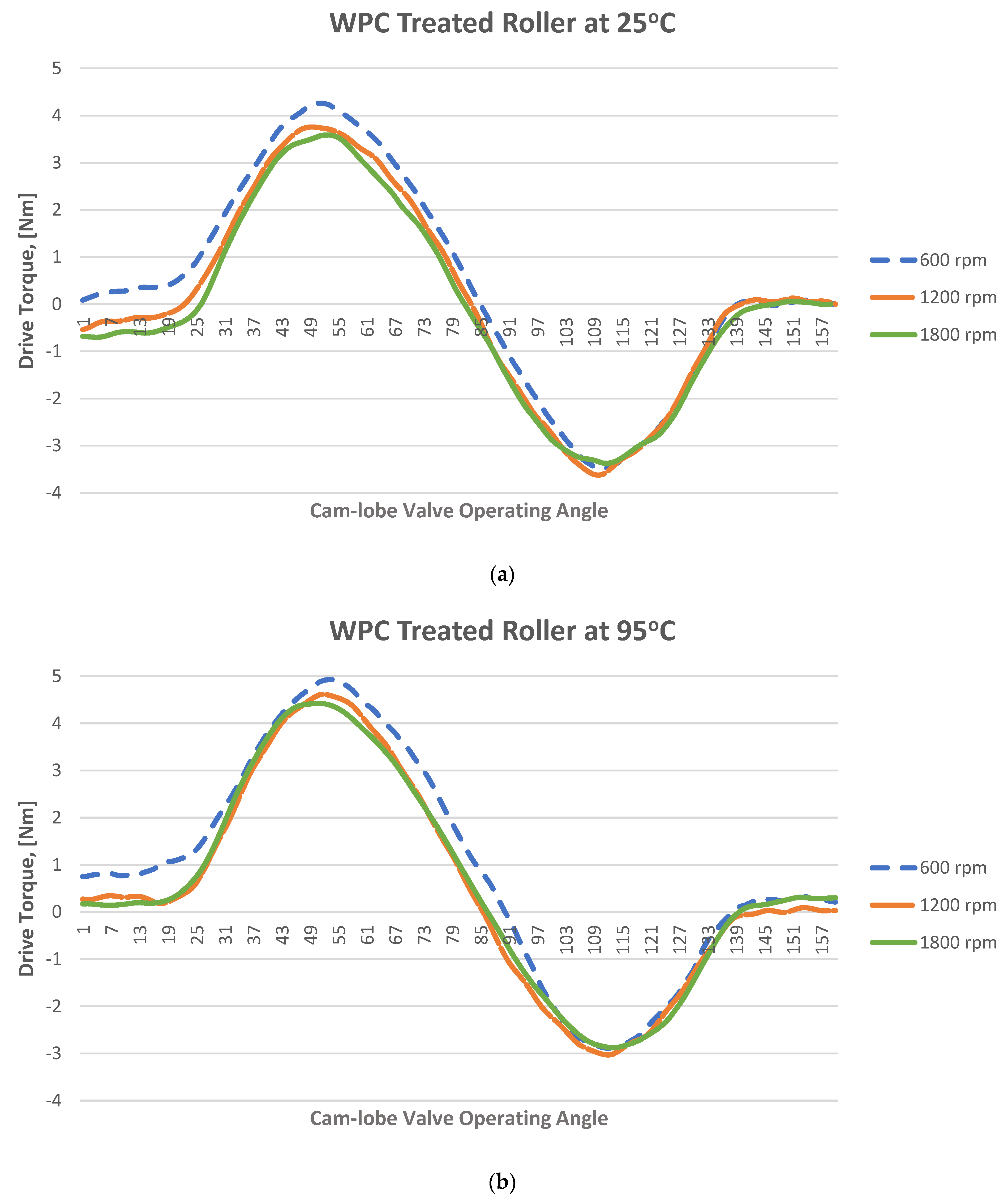
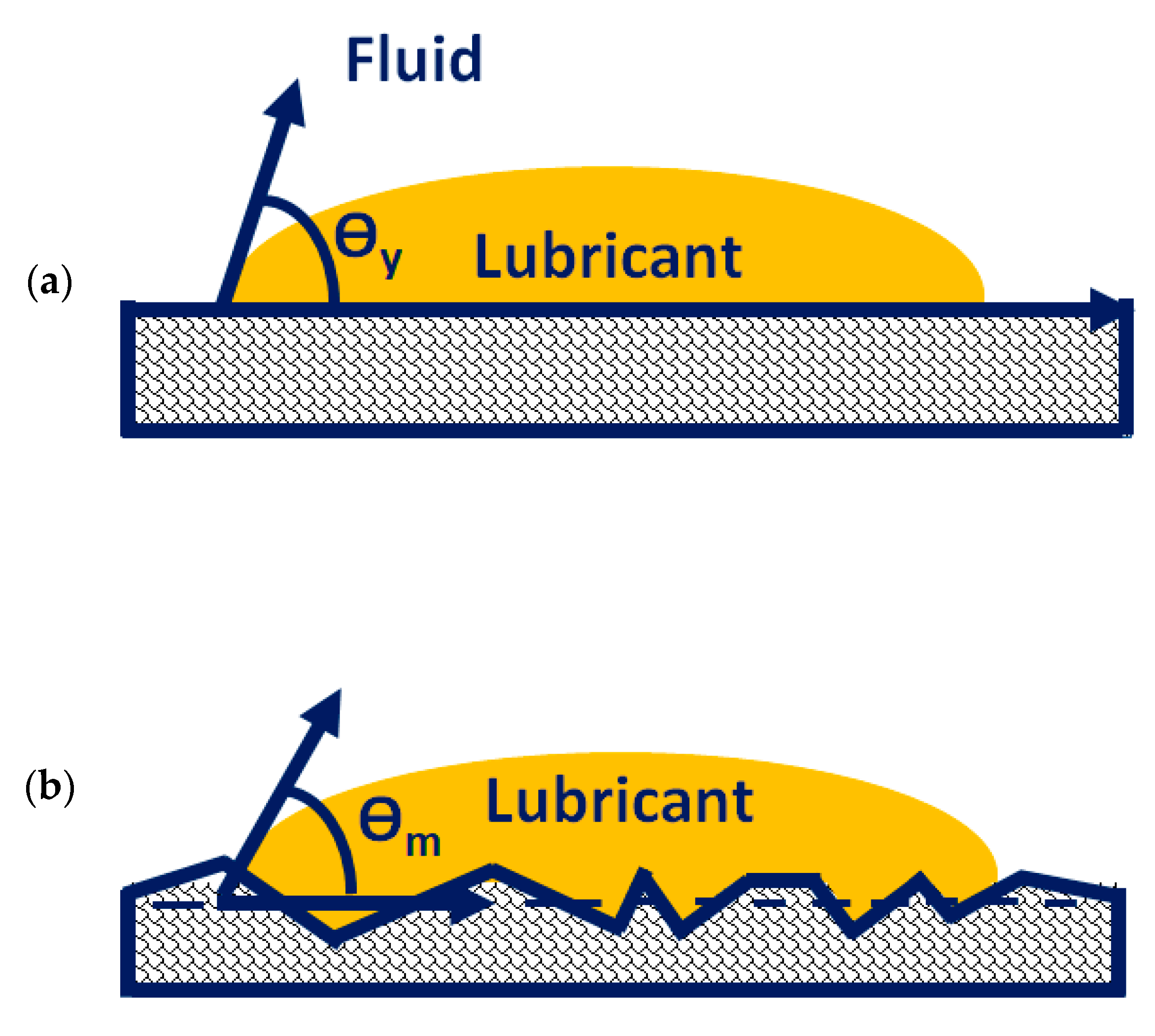
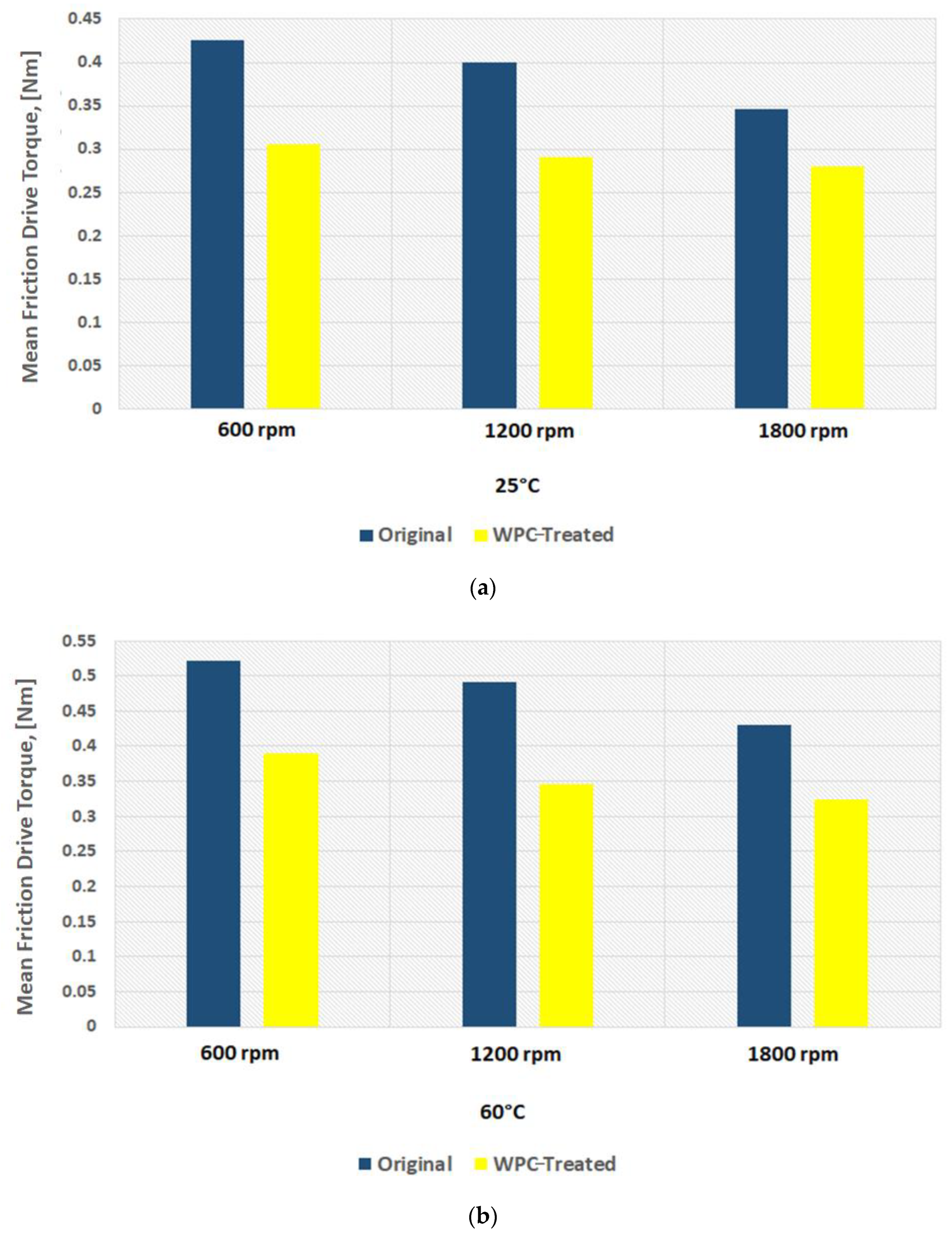
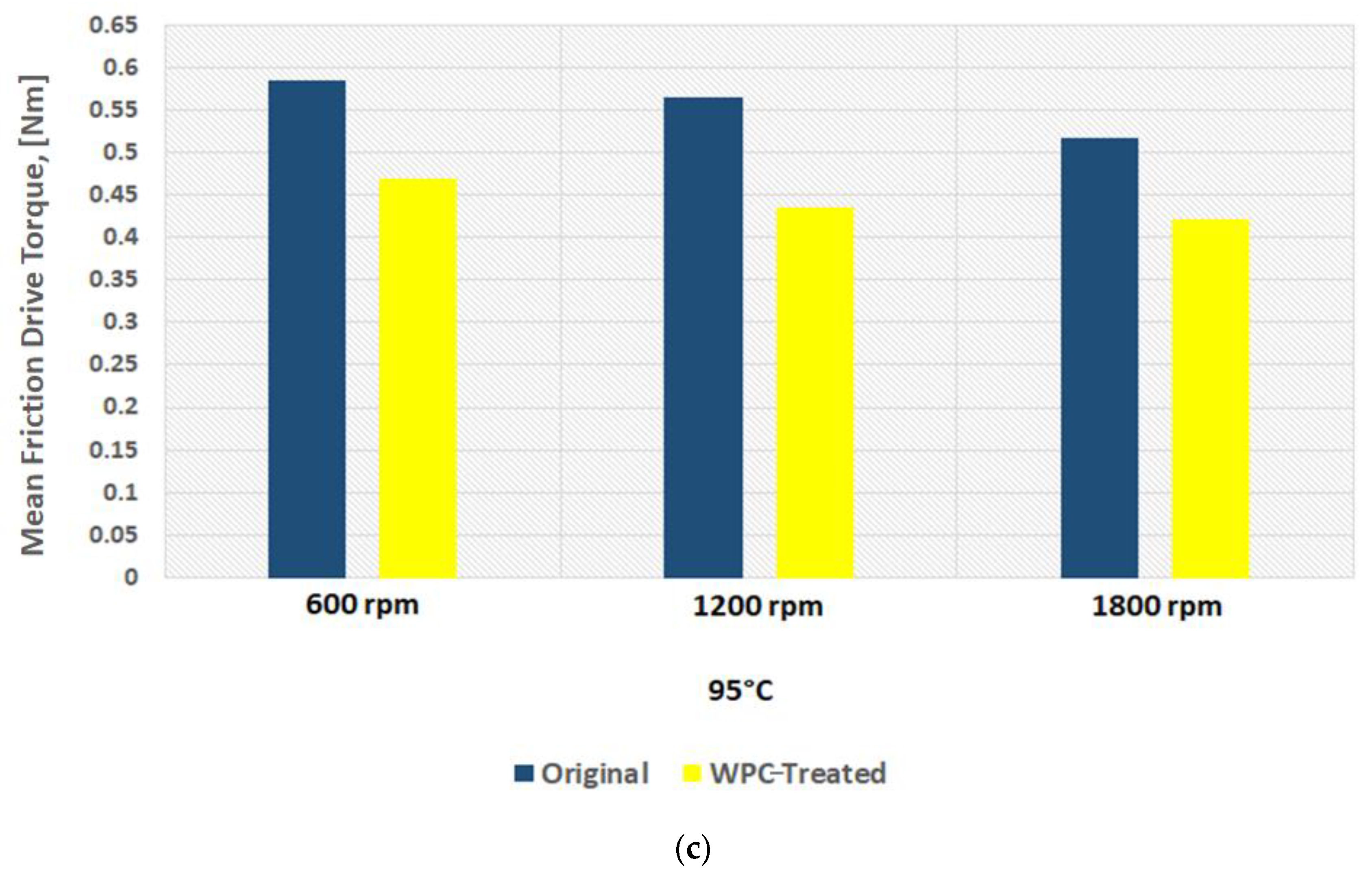
Disclaimer/Publisher’s Note: The statements, opinions and data contained in all publications are solely those of the individual author(s) and contributor(s) and not of MDPI and/or the editor(s). MDPI and/or the editor(s) disclaim responsibility for any injury to people or property resulting from any ideas, methods, instructions or products referred to in the content. |
© 2023 by the authors. Licensee MDPI, Basel, Switzerland. This article is an open access article distributed under the terms and conditions of the Creative Commons Attribution (CC BY) license (https://creativecommons.org/licenses/by/4.0/).
Share and Cite
Bhutta, M.U.; Najeeb, M.H.; Abdullah, M.U.; Shah, S.R.; Khurram, M.; Mufti, R.A.; Ogawa, K.; Aslam, J.; Zahid, R.; Ali, M.A.; et al. Experimental Investigation of Engine Valve Train Friction Considering Effects of Operating Conditions and WPC Surface Treatment. Materials 2023, 16, 3431. https://doi.org/10.3390/ma16093431
Bhutta MU, Najeeb MH, Abdullah MU, Shah SR, Khurram M, Mufti RA, Ogawa K, Aslam J, Zahid R, Ali MA, et al. Experimental Investigation of Engine Valve Train Friction Considering Effects of Operating Conditions and WPC Surface Treatment. Materials. 2023; 16(9):3431. https://doi.org/10.3390/ma16093431
Chicago/Turabian StyleBhutta, Muhammad Usman, Muhammad Huzaifa Najeeb, Muhammad Usman Abdullah, Samiur Rahman Shah, Muhammad Khurram, Riaz Ahmad Mufti, Kiyotaka Ogawa, Jawad Aslam, Rehan Zahid, Mian Ashfaq Ali, and et al. 2023. "Experimental Investigation of Engine Valve Train Friction Considering Effects of Operating Conditions and WPC Surface Treatment" Materials 16, no. 9: 3431. https://doi.org/10.3390/ma16093431
APA StyleBhutta, M. U., Najeeb, M. H., Abdullah, M. U., Shah, S. R., Khurram, M., Mufti, R. A., Ogawa, K., Aslam, J., Zahid, R., Ali, M. A., & Arshad, M. (2023). Experimental Investigation of Engine Valve Train Friction Considering Effects of Operating Conditions and WPC Surface Treatment. Materials, 16(9), 3431. https://doi.org/10.3390/ma16093431






